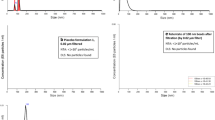Abstract
Dynamic light scattering (DLS) and nanoparticle tracking analysis (NTA) are two orthogonal and complementary methods of measuring size of particles in a sample. These technologies use the theory of Brownian motion by analyzing the random changes of light intensity scattered by particles in solution. Both techniques can be used to characterize particle size distribution of proteins and formulations in the nanometer to low micron range.
Each method has benefits over the other. DLS is a quick and simple measurement that is ideal for monodisperse particles and can also analyze a distribution of particles over a wide range of sizes. NTA provides a size distribution that is less susceptible to the influence of a few large particles, and has the added benefit of being able to measure particle concentration. Here we describe methods for measuring the particle size and concentration of an oil-in-water nanoemulsion.
Access this chapter
Tax calculation will be finalised at checkout
Purchases are for personal use only
Similar content being viewed by others
References
Bachmann MF, Jennings GT (2010) Vaccine delivery: a matter of size, geometry, kinetics and molecular patterns. Nat Rev Immunol 10(11):787–796
Bachmann MF, Jennings GT (2010) Vaccine delivery: a matter of size, geometry, kinetics and molecular patterns. Nat Rev Immunol 10(11):787–796
Shah RR et al (2014) The impact of size on particulate vaccine adjuvants. Nanomedicine (Lond) 9(17):2671–2681
Xiang SD et al (2006) Pathogen recognition and development of particulate vaccines: does size matter? Methods 40(1):1–9
Yu Z, Reid JC, Yang YP (2013) Utilizing dynamic light scattering as a process analytical technology for protein folding and aggregation monitoring in vaccine manufacturing. J Pharm Sci 102(12):4284–4290
Filipe V, Hawe A, Jiskoot W (2010) Critical evaluation of Nanoparticle Tracking Analysis (NTA) by NanoSight for the measurement of nanoparticles and protein aggregates. Pharm Res 27(5):796–810
Jornada DS et al (2012) Lipid-core nanocapsules: mechanism of self-assembly, control of size and loading capacity. Soft Matter 8(24):6646–6655
Malvern Instruments Limited (2015) Orthogonal and complementary nanoparticle characterization techniques, combining dynamic light scattering with nanoparticle tracking analysis. White Paper. Available from: http://www.malvern.com/en/support/resource-center/Whitepapers/WP151106OrthogonalComplementaryNanomaterialCharacterisationTechniques.aspx
Rahimian S et al (2015) Polymeric nanoparticles for co-delivery of synthetic long peptide antigen and poly IC as therapeutic cancer vaccine formulation. J Control Release 203:16–22
Malvern Instruments Limited (2014) Dynamic light scattering: an introduction in 30 minutes. Technical Note. Available from: http://www.malvern.com/en/support/resource-center/technical-notes/TN101104DynamicLightScatteringIntroduction.aspx
Frisken BJ (2001) Revisiting the method of cumulants for the analysis of dynamic light-scattering data. Appl Opt 40(24):4087–4091
Mailer AG, Clegg PS, Pusey PN (2015) Particle sizing by dynamic light scattering: non-linear cumulant analysis. J Phys Condens Matter 27(14):145102
Pecora R (1985) Dynamic light scattering: applications of photon correlation spectroscopy. Plenum Press, New York
Koppel DE (1972) Analysis of macromolecular polydispersity in intensity correlation spectroscopy: the method of cumulants. J Chem Phys 57(11):4814–4820
Burchard W (1992) Static and dynamic light scattering approaches to structure determination of biopolymers. In: Harding SE, Sattelle DB, Bloomfield DA (eds) Laser light scattering in biochemistry. Royal Society of Chemistry: Cambridge, UK. p 3–22
Malvern Instruments Limited (2015) Application of Dynamic Light Scattering (DLS) to protein therapeutic formulations: principles, measurements and analysis. Available from http://www.malvern.com/en/support/resource-center/Whitepapers/WP140404ApplicDLSprotein4FAQ.aspx
Malvern Instruments Limited (2013) Zetasizer Nano Series user manual. Cited Man0485 Issue 1.1 Available from http://www.malvern.com/en/support/resource-center/user-manuals/MAN0485EN.aspx
Malvern Instrument Limited (2015) NanoSight LM10 operating manual. Cited Man0510; Available from http://www.malvern.com/en/support/resource-center/user-manuals/MAN0510EN.aspx
Malvern Instruments Limited (2014) Zetasizer Nano Series accessories guide. Man0487 Issue 2.0; Available from http://www.malvern.com/en/support/resource-center/user-manuals/MAN0487EN.aspx
Standardization., G.I.O.f., ISO 22412, in Particle Size Analysis—Dynamic Light Scattering (DLS). 2008
Malvern Instruments Limited (2015) NanoSight syringe pump operating manual.[MAN0534-03-EN-00]. Available from http://www.malvern.com/en/support/resource-center/user-manuals/MAN0534EN.aspx
Author information
Authors and Affiliations
Corresponding author
Editor information
Editors and Affiliations
Rights and permissions
Copyright information
© 2017 Springer Science+Business Media New York
About this protocol
Cite this protocol
Chan, M.Y., Dowling, Q.M., Sivananthan, S.J., Kramer, R.M. (2017). Particle Sizing of Nanoparticle Adjuvant Formulations by Dynamic Light Scattering (DLS) and Nanoparticle Tracking Analysis (NTA). In: Fox, C. (eds) Vaccine Adjuvants. Methods in Molecular Biology, vol 1494. Humana Press, New York, NY. https://doi.org/10.1007/978-1-4939-6445-1_17
Download citation
DOI: https://doi.org/10.1007/978-1-4939-6445-1_17
Published:
Publisher Name: Humana Press, New York, NY
Print ISBN: 978-1-4939-6443-7
Online ISBN: 978-1-4939-6445-1
eBook Packages: Springer Protocols




